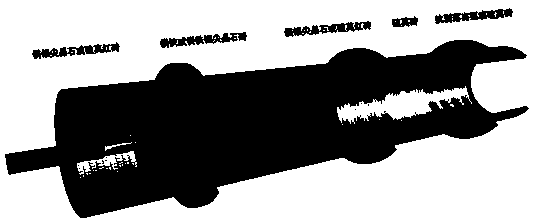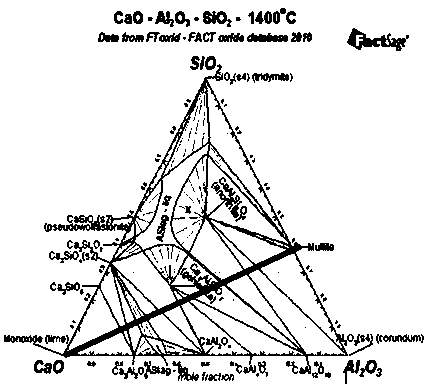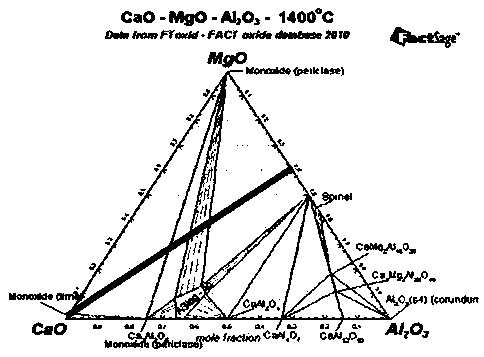A kind of preparation method of low thermal conductivity magnesia-aluminum spinel brick
A magnesia-alumina spinel brick, low thermal conductivity technology, applied in chemical instruments and methods, manufacturing tools, ceramic layered products, etc. Effects of stress and thermal conductivity reduction
- Summary
- Abstract
- Description
- Claims
- Application Information
AI Technical Summary
Problems solved by technology
Method used
Image
Examples
Embodiment 1
[0044] In this example, electric fusion and high-purity composite raw materials are used to produce low thermal conductivity magnesium-aluminum spinel bricks for the transition zone of cement kilns. Wherein the formula of each layer material is:
[0045] Refractory layer: sintered magnesia with a particle size of 5-0mm accounts for 45% of the total, and magnesium-aluminum spinel with a particle size of 4-0mm accounts for 10% of the total. Fused magnesia with a particle size of 3-0mm accounts for 40% of the total. The corundum particle size is 2-0mm, accounting for 5% of the total.
[0046] The specific ratio is as follows:
[0047] 5-0mm sintered magnesia 45%
[0048] 4-0mm magnesium aluminum spinel 10%
[0049] 3-0mm fused magnesia 40%
[0050] 2-0mm Corundum 5%
[0051] The above-mentioned raw materials are weighed, mixed, and kneaded with a Na-based binder to make low thermal conductivity magnesium-aluminum spinel brick refractory layer raw materials.
[0052] Insula...
Embodiment 2
[0060] In this example, electric fusion and high-purity composite raw materials are used to produce low thermal conductivity magnesium-aluminum spinel bricks for the transition zone of cement kilns. Wherein the formula of each layer material is:
[0061] Refractory layer: sintered magnesia with a particle size of 5-0mm accounts for 60% of the total, and magnesium-aluminum spinel with a particle size of 4-0mm accounts for 10% of the total. Fused magnesia with a particle size of 3-0mm accounts for 25% of the total. The corundum particle size is 2-0mm, accounting for 5% of the total.
[0062] The specific ratio is as follows:
[0063] 5-0mm sintered magnesia 60%
[0064] 4-0mm magnesium aluminum spinel 10%
[0065] 3-0mm fused magnesia 25%
[0066] 2-0mm Corundum 5%
[0067] The above-mentioned raw materials are weighed, mixed, and kneaded with a Na-based binder to make low thermal conductivity magnesium-aluminum spinel brick refractory layer raw materials.
[0068] Insula...
Embodiment 3
[0076] In this example, electric fusion and high-purity composite raw materials are used to produce low thermal conductivity magnesium-aluminum spinel bricks for the transition zone of cement kilns. Wherein the formula of each layer material is:
[0077] Refractory layer: sintered magnesia with a particle size of 5-0mm accounts for 68% of the total, and magnesium-aluminum spinel with a particle size of 4-0mm accounts for 10% of the total. Fused magnesia with a particle size of 3-0mm accounts for 19% of the total. The corundum particle size is 2-0mm, accounting for 3% of the total.
[0078] The specific ratio is as follows:
[0079] 5-0mm sintered magnesia 68%
[0080] 4-0mm magnesium aluminum spinel 10%
[0081] 3-0mm fused magnesia 19%
[0082] 2-0mm Corundum 3%
[0083] The above-mentioned raw materials are weighed, mixed, and kneaded with a Na-based binder to make low thermal conductivity magnesium-aluminum spinel brick refractory layer raw materials.
[0084] Insula...
PUM
| Property | Measurement | Unit |
|---|---|---|
| particle size | aaaaa | aaaaa |
| particle size | aaaaa | aaaaa |
| particle size | aaaaa | aaaaa |
Abstract
Description
Claims
Application Information
 Login to View More
Login to View More - R&D
- Intellectual Property
- Life Sciences
- Materials
- Tech Scout
- Unparalleled Data Quality
- Higher Quality Content
- 60% Fewer Hallucinations
Browse by: Latest US Patents, China's latest patents, Technical Efficacy Thesaurus, Application Domain, Technology Topic, Popular Technical Reports.
© 2025 PatSnap. All rights reserved.Legal|Privacy policy|Modern Slavery Act Transparency Statement|Sitemap|About US| Contact US: help@patsnap.com



